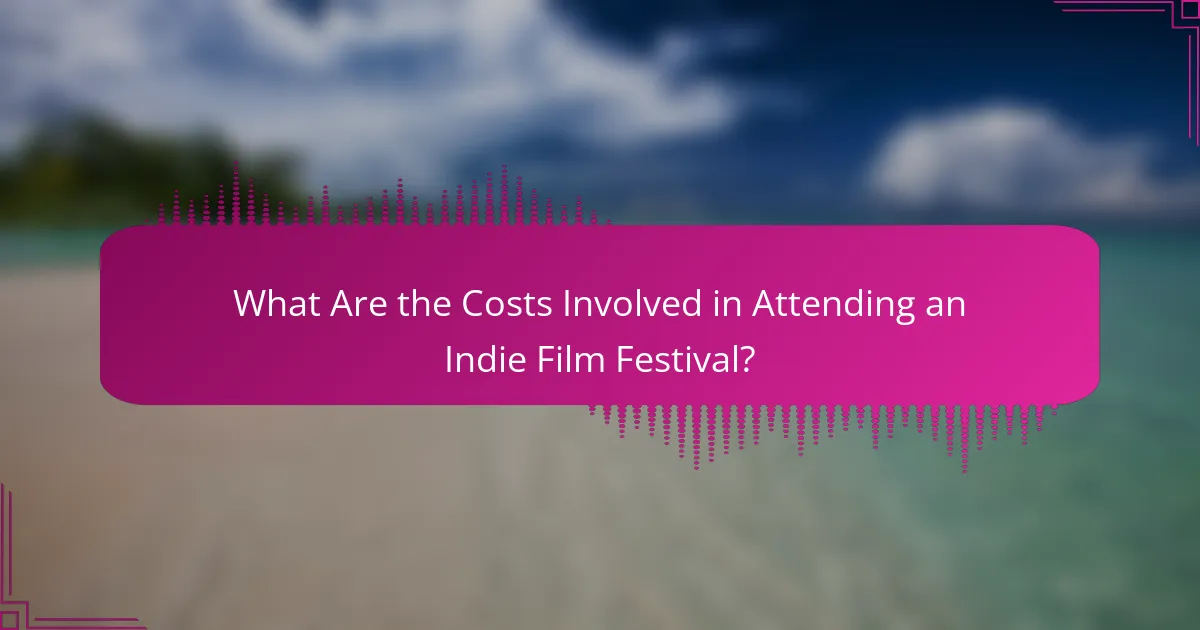Attending an indie film festival can be an exhilarating experience, but careful planning is essential to make the most of it. By organizing your schedule, prioritizing films that resonate with your interests, and allowing time for networking and relaxation, you can fully enjoy the vibrant atmosphere and unique offerings of the festival. With a diverse range of films and opportunities to connect with filmmakers and fellow enthusiasts, your festival experience can be both enriching and memorable.

How to Plan Your Indie Film Festival Experience?
Planning your indie film festival experience involves creating a structured approach to maximize enjoyment and networking opportunities. By organizing your schedule, prioritizing films, and allowing time for breaks, you can fully immerse yourself in the festival atmosphere.
Create a Daily Schedule
Start by outlining a daily schedule that includes film screenings, panels, and events. Use the festival program to identify the times and locations of each activity. A well-structured schedule helps you manage your time effectively and ensures you don’t miss key events.
Consider using a digital calendar or a planner app to keep track of your schedule. This allows for easy adjustments if screenings overlap or if you discover new films you want to see.
Prioritize Must-See Films
Identify must-see films ahead of time by researching the lineup and reading reviews or synopses. Focus on films that resonate with your interests or have received buzz from previous festivals. Prioritizing these films ensures you allocate time for the most impactful experiences.
Make a list of your top five to ten films and mark their screening times. This way, you can plan your day around these key selections while remaining flexible for spontaneous choices.
Include Networking Opportunities
Networking is a crucial aspect of indie film festivals. Look for events such as Q&A sessions, workshops, or meet-and-greets that facilitate connections with filmmakers and fellow attendees. Engaging in these opportunities can lead to valuable industry contacts.
Set aside specific times in your schedule for networking. Approach people during breaks or after screenings to discuss films and share insights, which can enhance your festival experience.
Allocate Time for Breaks
Incorporating breaks into your schedule is essential for maintaining energy and focus throughout the festival. Plan for short breaks between screenings to recharge and reflect on what you’ve seen. This can help prevent burnout from a packed schedule.
Consider using breaks to grab a snack or explore the festival venue. Allowing yourself downtime can enhance your overall enjoyment and help you engage more fully with the films.
Use Festival Apps for Updates
Many film festivals offer dedicated apps that provide real-time updates on screenings, events, and changes in the schedule. Download the official festival app to stay informed and receive notifications about any last-minute changes.
Utilizing the app can also help you discover additional events or films that you might have missed in the printed program. Make it a habit to check the app regularly throughout the day for the latest information.

What Are the Best Indie Film Festivals in the US?
The best indie film festivals in the US showcase a diverse range of films and provide unique networking opportunities for filmmakers and audiences alike. Notable festivals include Sundance, SXSW, Tribeca, and AFI Fest, each offering distinct experiences and programming.
Sundance Film Festival
Sundance Film Festival, held annually in Park City, Utah, is one of the most prestigious indie film festivals in the world. It typically takes place in January and features a wide array of films, including documentaries and narrative features, often premiering works from emerging filmmakers.
Attendees should consider purchasing tickets early, as popular screenings can sell out quickly. The festival also offers panels and discussions, providing insights into the filmmaking process and industry trends.
South by Southwest (SXSW)
South by Southwest (SXSW) is a dynamic festival that combines film, music, and interactive media, taking place in Austin, Texas, every March. It is known for its vibrant atmosphere and diverse programming that includes both established and emerging talent.
To maximize your experience, plan your schedule in advance and prioritize must-see films and events. SXSW also features networking opportunities, making it ideal for filmmakers looking to connect with industry professionals.
Tribeca Film Festival
Tribeca Film Festival, founded in 2002 in New York City, showcases innovative storytelling across various genres. Typically held in April, it features screenings, panel discussions, and immersive experiences that engage audiences and creators alike.
Attendees should explore the festival’s unique venues and consider attending Q&A sessions with filmmakers for deeper insights into the films. Purchasing a festival pass can provide access to multiple screenings and events.
AFI Fest
AFI Fest, organized by the American Film Institute, takes place in Los Angeles every November. This festival highlights international cinema and often includes award contenders, making it a significant event for film enthusiasts.
To get the most out of AFI Fest, take advantage of the free screenings and consider attending industry panels. Engaging with filmmakers during Q&A sessions can enhance your understanding of the films and the creative process behind them.

How to Choose Films to Watch at the Festival?
To choose films at the festival, prioritize your interests and explore various genres. Consider factors like film synopses, director and cast credentials, and reviews to make informed decisions.
Research Film Synopses
Start by reading the synopses of the films on the festival schedule. These brief descriptions provide insight into the plot, themes, and tone, helping you identify films that resonate with your preferences.
Look for unique storylines or compelling premises that stand out. If a synopsis mentions elements like “coming-of-age” or “social commentary,” consider how those themes align with your interests.
Check Director and Cast Credentials
Investigate the backgrounds of the directors and cast members involved in the films. Established filmmakers often bring a certain level of quality and expertise, while emerging talent can offer fresh perspectives.
Look for previous works by the director or notable performances by the cast. A director known for award-winning films or a cast with a strong track record can be indicators of a film’s potential quality.
Read Reviews and Ratings
Before finalizing your film choices, read reviews and ratings from critics and audiences. Websites like Rotten Tomatoes or IMDb can provide a general consensus on a film’s reception.
Pay attention to both professional critiques and audience feedback. A film with high ratings and positive reviews is more likely to deliver an enjoyable experience, while mixed reviews might warrant caution.

What Networking Strategies Should You Use?
Effective networking strategies at an indie film festival can enhance your connections and opportunities. Focus on engaging with other attendees, filmmakers, and industry professionals through various interactive formats.
Attend Q&A Sessions
Q&A sessions provide a unique opportunity to engage directly with filmmakers and industry experts. Prepare thoughtful questions in advance to stimulate conversation and showcase your interest in their work.
These sessions often attract a mix of attendees, from aspiring filmmakers to seasoned professionals, creating a rich environment for networking. After the session, approach speakers and participants to discuss their insights and share your own experiences.
Join Festival Workshops
Participating in workshops allows you to gain practical skills while connecting with like-minded individuals. Look for workshops that align with your interests, whether in directing, screenwriting, or production.
These smaller, focused groups foster deeper interactions, making it easier to build relationships. Consider exchanging contact information with fellow participants to continue discussions beyond the festival.
Connect on Social Media
Social media is a powerful tool for networking before, during, and after the festival. Use platforms like Twitter, Instagram, and LinkedIn to follow filmmakers, industry professionals, and fellow attendees.
Engage with their content by commenting and sharing your thoughts. After the festival, maintain these connections by reaching out with a personalized message, referencing your interactions at the event.

What Are the Costs Involved in Attending an Indie Film Festival?
Attending an indie film festival typically involves several costs, including ticket prices, accommodation, transportation, and food. Understanding these expenses can help you budget effectively and enhance your overall experience.
Ticket Prices
Ticket prices for indie film festivals can vary widely, often ranging from $10 to $50 per screening, depending on the festival’s prestige and location. Some festivals offer package deals that can reduce the cost per ticket if you plan to see multiple films.
Additionally, many festivals provide discounted rates for students, seniors, or early bird purchases. It’s advisable to check the festival’s official website for specific pricing and any available promotions to maximize your savings.
